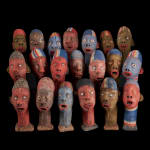Collection of 20 Decorative and very Expressive Mudzini Reliquary Heads,Bembe People,DRC.
20th Century
Organic material
9 x 12 cm
3 1/2 x 4 3/4 in
3 1/2 x 4 3/4 in
1909
€ 5,800.00
Plus d'images
-
(View a larger image of thumbnail 1
)

-
(View a larger image of thumbnail 2
)

-
(View a larger image of thumbnail 3
)

-
(View a larger image of thumbnail 4
)

-
(View a larger image of thumbnail 5
)

-
(View a larger image of thumbnail 6
)

-
(View a larger image of thumbnail 7
)

-
(View a larger image of thumbnail 8
)

-
(View a larger image of thumbnail 9
)

-
(View a larger image of thumbnail 10
)

-
(View a larger image of thumbnail 11
)

-
(View a larger image of thumbnail 12
)

-
(View a larger image of thumbnail 13
)

-
(View a larger image of thumbnail 14
)

-
(View a larger image of thumbnail 15
)

-
(View a larger image of thumbnail 16
)

-
(View a larger image of thumbnail 17
)

-
(View a larger image of thumbnail 18
)

-
(View a larger image of thumbnail 19
)

-
(View a larger image of thumbnail 20
)

-
(View a larger image of thumbnail 21
)

The Bembe people gave a name to the statues of their ancestors. These ancestral statues were kept together in small sanctuaries in the houses. So, the Mudzini facilitated the contact between the living and the dead. They also acted as protectors of their family and the community. Some months after the death of a person, the remains from his corpse were dug up, and residues such as hair or nails were put into the Mudzini reliquary. These heads date from the second half of the 20th century.




















